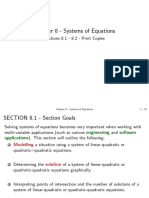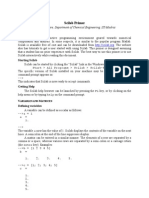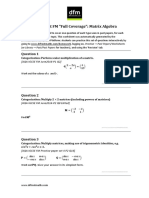Matrices: - Matrix Is 2-D Array of M Rows by N Columns
Uploaded by
Ravi Sharma BhandariMatrices: - Matrix Is 2-D Array of M Rows by N Columns
Uploaded by
Ravi Sharma Bhandari1
1.00 Lecture 22
Matrices
Reading for next time: Numerical Recipes, pp. 37-42
Matrices
Matrix is 2-D array of m rows by n columns
In math notation, we use index 1, m and 1, n.
In Java, we usually use index 0, m-1 and 0, n-1
They often represent a set of linear equations:
a
00
x
0
+ a
01
x
1
+ a
02
x
2
+ + a
0,n-1
x
n-1
= b
0
a
10
x
0
+ a
11
x
1
+ a
12
x
2
+ + a
1,n-1
x
n-1
= b
1
a
m-1,0
x
0
+ a
m-1,1
x
1
+ a
m-1,2
x
2
+ + a
m-1,n-1
x
n-1
= b
m-1
n unknowns x are related by m equations
Coefficients a are known, as are right hand side b
a
m-1,n-1
a
m-1,3
a
m-1,2
a
m-1,1
a
m-1,0
a
2n-1
a
23
a
22
a
21
a
20
a
1n-1
a
13
a
12
a
11
a
10
a
0n-1
a
03
a
02
a
01
a
00
2
Matrices, p.2
In this lecture we cover basic matrix
representation and manipulation
Used most often to prepare matrices for use in solving
linear systems, which we cover in next lecture
Java has 2-D arrays, declared as, for example
double[][] squareMatrix= new double[5][5];
But there are no built-in methods for them
So, its helpful to create a Matrix class:
Create methods to add, subtract, multiply, form identity
matrix, etc.
Sparse matrices are handled differently:
Almost all large matrices are extremely sparse (99%+ of
entries are zeros)
Store (i, j, value) in a list or 1-D array or other data
structure
2-D Arrays
data[0]
data[2]
data[1]
data[2]
data[3]
8.0 14.0 2.0 3.0
5.1 4.2 6.6 0.8
3.3 3.2 5.5 6.6
2.4 6.4 0.4 4.3
12.3 3.7 9.3 3.0
data
No. of rows=
data.length
No of columns=
data[0].length
A 2-D array is:
a reference to a 1-D array of references to 1-D arrays of data.
This is how well store the matrix data in class Matrix
data[0][0]
3
Matrix class, p.1
public class Matrix {
private double[][] data; // Reference to array
public Matrix(int m, int n) {
data = new double[m][n];
}
public void setIdentity() {
int i,j;
int nrows = data.length;
int ncols = data[0].length;
for(i=0; i<nrows; i++)
for(j=0; j<ncols; j++)
if(i == j)
data[i][j]= 1.0;
else
data[i][j]= 0.0; // Not really needed
} // since initialized=0
Matrix class, p.2
public int getNumRows() {
return data.length; }
public int getNumCols() {
return data[0].length; }
public double getElement(int i, int j) {
return data[i][j]; }
public void setElement(int i, int j, double val) {
data[i][j] = val; }
public Matrix addMatrices(Matrix b) {
Matrix result = null;
int nrows = data.length;
int ncols = data[0].length;
if (nrows==b.data.length && ncols==b.data[0].length) {
result = new Matrix(nrows, ncols);
for(int i=0; i<nrows; i++)
for(int j=0; j<ncols; j++)
result.data[i][j]= data[i][j]+ b.data[i][j]; }
return result;
}
4
Matrix class, p.3
public Matrix multMatrices(Matrix b) {
Matrix result = null;
int nrows = data.length;
int p = data[0].length;
if (p == b.data.length) {
result = new Matrix(nrows, b.data[0].length);
for(int i=0; i<nrows; i++)
for(int j=0; j<result.data[0].length; j++){
double t = 0.0;
for(int k=0; k<p; k++) {
t += data[i][k] * b.data[k][j]; }
result.data[i][j]= t; } }
return result;
}
public void print() {
for(int i=0; i< data.length; i++) {
for(int j=0; j< data[0].length; j++)
System.out.print(data[i][j] + " ");
System.out.println(); }
System.out.println();
}
}
MatrixTest
public class MatrixTest {
public static void main(String argv[]) {
Matrix mat1 = new Matrix(3,3);
Matrix mat2 = new Matrix(3,3);
mat1.setIdentity();
mat2.setIdentity();
Matrix res;
res = mat1.addMatrices(mat2);
System.out.println("mat1:");
mat1.print();
System.out.println("mat2:");
mat2.print();
System.out.println("mat1 + mat2:" );
res.print();
// Similar code for multiplication
// Add your exercise code here
}
}
5
Exercise
Download Matrix and MatrixTest from the Web site
Write a method multScalar() to multiply a matrix by a
scalar in class Matrix
Invoke your method from your MatrixTest class main
method
Hints for writing multScalar()
Use addMatrix() as a rough guide
Find the number of rows and columns in the matrix
Create a new Matrix object to return as the result
Loop through all entries (nested for loops) to multiply by
the scalar
Return the result
Modifying MatrixTest main() method:
Add a line to use the multScalar() method
Add another line to print the resulting matrix, using its
print() method
Exercise 2
Implement graphics transforms from last lecture
Instead of using Javas rotate() and scale()
methods, youll create matrices to represent
rotation and scaling, multiply them, and apply
them to a shape.
With some perseverance, your matrix
manipulations will yield the same result as Javas
methods!
6
Rotation
( ) ( )
( ) ( )
( ) ( )
( ) ( )
cos sin 0 cos sin
sin cos 0 sin cos
0 0 1 1 1
x x y
y x y
= +
( ( (
( ( (
( ( (
Scaling
0 0
0 0
0 0 1 1 1
x x
y y
s x s x
s y s y
( ( (
( ( (
=
( ( (
( ( (
7
Composing Transformations
Suppose we want to scale point (x, y) by 2 and then rotate
by 90 degrees.
0 1 0 2 0 0
1 0 0 0 2 0
0 0 1 0 0 1 1
x
y
| |
( ( (
|
( ( (
|
( ( (
|
( ( (
\ .
scale rotate
Composing Transformations, 2
Because matrix multiplication is associative, we can rewrite
this as
0 1 0 2 0 0
1 0 0 0 2 0
0 0 1 0 0 1 1
x
y
| |
( ( (
|
( ( (
|
( ( (
|
( ( (
\ .
0 2 0
2 0 0
0 0 1 1
x
y
( (
( (
=
( (
( (
8
Exercise
Download TransformTest, TransformPanel
TransformPanel rotates (by 18 ) and scales (by 2) a
rectangle using Java affine transforms
Run it to see the result
Download TransformTest1, TransformPanel1
These are skeletons for doing the rotations and scaling
through matrix multiplication yourself. You will:
Create two matrices (rotate, scale) with your Matrix class
Scale by 2 in the x and y directions and rotate by 18 (/10)
Look at the scaling and rotation matrices in previous slides
Multiply the 2 matrices, save them in Matrix result. Order
matters!
Try it both ways if you arent sure
Pass the values as arguments to AffineTransform() as
shown in TransformPanel1 code on the next slides
See if your AffineTransform produces the same result!
Exercise
import java.awt.*;
import javax.swing.*;
public class TransformTest {
public static void main(String args[]) {
JFrame frame = new JFrame("Rectangle transform");
frame.setDefaultCloseOperation(JFrame.EXIT_ON_CLOSE);
frame.setSize(500,500);
Container contentPane= frame.getContentPane();
TransformPanel panel = new TransformPanel();
contentPane.add(panel);
frame.setVisible(true);
}
}
9
Exercise
import javax.swing.*;
import java.awt.*;
import java.awt.geom.*; // For 2D classes
public class TransformPanel extends JPanel {
public void paintComponent(Graphics g) {
super.paintComponent(g);
Graphics2D g2= (Graphics2D) g;
Rectangle2D rect= new Rectangle2D.Double(0, 0, 50, 100);
g2.setPaint(Color.BLUE);
AffineTransform baseXf = new AffineTransform();
// Rotate by 18 degrees, then scale by 2 in x, y directions
baseXf.rotate(Math.PI/10.0);
baseXf.scale(2.0, 2.0);
g2.transform(baseXf);
g2.draw(rect);
}
}
R
e
p
l
a
c
e
t
h
e
s
e
l
i
n
e
s
Exercise
public class TransformPanel1 extends JPanel {
public void paintComponent(Graphics g) {
// Same initial lines: superclass, cast g2, new rectangle
g2.setPaint(Color.MAGENTA);
Matrix s = new Matrix(3, 3);
// Set its elements to scale rectangle by 2
// Your code here
s.print();
Matrix r = new Matrix(3, 3); // Rotate
double a = Math.PI / 10; // 18 degree angle
// Set elements to rotate 18 degrees; use Math.sin() and cos()
// Your code here
r.print();
// Multiply r and s to get Matrix result
// Your code here.
result.print();
double m00 = result.getElement(0, 0);
double m01 = result.getElement(0, 1);
// Etc. Coefficients inserted in COLUMN order. Done for you.
AffineTransform baseXf =
new AffineTransform(m00, m10, m01, m11, m02, m12);
g2.transform(baseXf); // Only 6 elements vary in xform
g2.draw(rect); } }
10
Exercise
You might also like
- Matrices: - Matrix Is 2-D Array of M Rows by N ColumnsNo ratings yetMatrices: - Matrix Is 2-D Array of M Rows by N Columns14 pages
- Lab Experiment-5 Discrete Cosine Transform/discrete Fourier Transform AimNo ratings yetLab Experiment-5 Discrete Cosine Transform/discrete Fourier Transform Aim29 pages
- Applications of Space Science PHYC40730 Satellite Navigation Assignment (Submission Deadline: See Module's Brightspace)No ratings yetApplications of Space Science PHYC40730 Satellite Navigation Assignment (Submission Deadline: See Module's Brightspace)6 pages
- ECOM 6302: Engineering Optimization: Chapter Three100% (1)ECOM 6302: Engineering Optimization: Chapter Three56 pages
- Week 02: 1 - Vector and Matrices 2 - Graphs and Plots in MATLABNo ratings yetWeek 02: 1 - Vector and Matrices 2 - Graphs and Plots in MATLAB42 pages
- Inverse kinematics using neural networksNo ratings yetInverse kinematics using neural networks8 pages
- Introduction To Computer Graphics CS 445 / 645: TransformationsNo ratings yetIntroduction To Computer Graphics CS 445 / 645: Transformations52 pages
- Homework Solutions For (Nonlinear Vibration) Mustafa Alajrawee Student No. 40240413006 Dr. DardallNo ratings yetHomework Solutions For (Nonlinear Vibration) Mustafa Alajrawee Student No. 40240413006 Dr. Dardall14 pages
- Introduction To Matlab: By: Kichun Lee Industrial Engineering, Hanyang UniversityNo ratings yetIntroduction To Matlab: By: Kichun Lee Industrial Engineering, Hanyang University34 pages
- Magesh 21BMC026 Matlab Task 8 CompletedNo ratings yetMagesh 21BMC026 Matlab Task 8 Completed103 pages
- Introduction To Matlab: By: İ.Yücel ÖzbekNo ratings yetIntroduction To Matlab: By: İ.Yücel Özbek34 pages
- CGIP - Mod1 - PPT - 3 (Line, Circ Algo)No ratings yetCGIP - Mod1 - PPT - 3 (Line, Circ Algo)61 pages
- Design and Analysis of Algorithms Lab Aman DubeyNo ratings yetDesign and Analysis of Algorithms Lab Aman Dubey11 pages
- Introduction To Programming in MATLAB: Lecture 3: Solving Equations and Curve FittingNo ratings yetIntroduction To Programming in MATLAB: Lecture 3: Solving Equations and Curve Fitting39 pages
- Programming Exercises For R: by Nastasiya F. Grinberg & Robin J. Reed50% (2)Programming Exercises For R: by Nastasiya F. Grinberg & Robin J. Reed35 pages
- MATLAB ® - The Language of Technical ComputingNo ratings yetMATLAB ® - The Language of Technical Computing26 pages
- MAE 152 Computer Graphics For Scientists and Engineers: Splines and Bezier CurvesNo ratings yetMAE 152 Computer Graphics For Scientists and Engineers: Splines and Bezier Curves76 pages
- Design & Analysis of Algorithms: Bits, Pilani - K. K. Birla Goa CampusNo ratings yetDesign & Analysis of Algorithms: Bits, Pilani - K. K. Birla Goa Campus27 pages
- A Brief Introduction to MATLAB: Taken From the Book "MATLAB for Beginners: A Gentle Approach"From EverandA Brief Introduction to MATLAB: Taken From the Book "MATLAB for Beginners: A Gentle Approach"2.5/5 (2)
- Matrices with MATLAB (Taken from "MATLAB for Beginners: A Gentle Approach")From EverandMatrices with MATLAB (Taken from "MATLAB for Beginners: A Gentle Approach")3/5 (4)
- Student Solutions Manual to Accompany Economic Dynamics in Discrete Time, secondeditionFrom EverandStudent Solutions Manual to Accompany Economic Dynamics in Discrete Time, secondedition4.5/5 (2)
- Graphs with MATLAB (Taken from "MATLAB for Beginners: A Gentle Approach")From EverandGraphs with MATLAB (Taken from "MATLAB for Beginners: A Gentle Approach")4/5 (2)
- Design of Rectangular Beam: Calculation For MomentNo ratings yetDesign of Rectangular Beam: Calculation For Moment1 page
- Reservoir Sedimentation Management With Bypass TunNo ratings yetReservoir Sedimentation Management With Bypass Tun9 pages
- Seismic Performance Evaluation of Existing RC Buildings Designed As Per Past Codes of PracticeNo ratings yetSeismic Performance Evaluation of Existing RC Buildings Designed As Per Past Codes of Practice17 pages
- Matrices: - Matrix Is 2-D Array of M Rows by N ColumnsMatrices: - Matrix Is 2-D Array of M Rows by N Columns
- Lab Experiment-5 Discrete Cosine Transform/discrete Fourier Transform AimLab Experiment-5 Discrete Cosine Transform/discrete Fourier Transform Aim
- Applications of Space Science PHYC40730 Satellite Navigation Assignment (Submission Deadline: See Module's Brightspace)Applications of Space Science PHYC40730 Satellite Navigation Assignment (Submission Deadline: See Module's Brightspace)
- ECOM 6302: Engineering Optimization: Chapter ThreeECOM 6302: Engineering Optimization: Chapter Three
- Week 02: 1 - Vector and Matrices 2 - Graphs and Plots in MATLABWeek 02: 1 - Vector and Matrices 2 - Graphs and Plots in MATLAB
- Introduction To Computer Graphics CS 445 / 645: TransformationsIntroduction To Computer Graphics CS 445 / 645: Transformations
- Homework Solutions For (Nonlinear Vibration) Mustafa Alajrawee Student No. 40240413006 Dr. DardallHomework Solutions For (Nonlinear Vibration) Mustafa Alajrawee Student No. 40240413006 Dr. Dardall
- Introduction To Matlab: By: Kichun Lee Industrial Engineering, Hanyang UniversityIntroduction To Matlab: By: Kichun Lee Industrial Engineering, Hanyang University
- Introduction To Programming in MATLAB: Lecture 3: Solving Equations and Curve FittingIntroduction To Programming in MATLAB: Lecture 3: Solving Equations and Curve Fitting
- Programming Exercises For R: by Nastasiya F. Grinberg & Robin J. ReedProgramming Exercises For R: by Nastasiya F. Grinberg & Robin J. Reed
- MAE 152 Computer Graphics For Scientists and Engineers: Splines and Bezier CurvesMAE 152 Computer Graphics For Scientists and Engineers: Splines and Bezier Curves
- Design & Analysis of Algorithms: Bits, Pilani - K. K. Birla Goa CampusDesign & Analysis of Algorithms: Bits, Pilani - K. K. Birla Goa Campus
- A Brief Introduction to MATLAB: Taken From the Book "MATLAB for Beginners: A Gentle Approach"From EverandA Brief Introduction to MATLAB: Taken From the Book "MATLAB for Beginners: A Gentle Approach"
- A-level Maths Revision: Cheeky Revision ShortcutsFrom EverandA-level Maths Revision: Cheeky Revision Shortcuts
- Matrices with MATLAB (Taken from "MATLAB for Beginners: A Gentle Approach")From EverandMatrices with MATLAB (Taken from "MATLAB for Beginners: A Gentle Approach")
- MATLAB for Beginners: A Gentle Approach - Revised EditionFrom EverandMATLAB for Beginners: A Gentle Approach - Revised Edition
- Student Solutions Manual to Accompany Economic Dynamics in Discrete Time, secondeditionFrom EverandStudent Solutions Manual to Accompany Economic Dynamics in Discrete Time, secondedition
- Graphs with MATLAB (Taken from "MATLAB for Beginners: A Gentle Approach")From EverandGraphs with MATLAB (Taken from "MATLAB for Beginners: A Gentle Approach")
- Design of Rectangular Beam: Calculation For MomentDesign of Rectangular Beam: Calculation For Moment
- Reservoir Sedimentation Management With Bypass TunReservoir Sedimentation Management With Bypass Tun
- Seismic Performance Evaluation of Existing RC Buildings Designed As Per Past Codes of PracticeSeismic Performance Evaluation of Existing RC Buildings Designed As Per Past Codes of Practice











































































